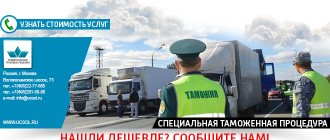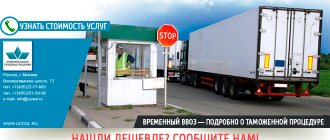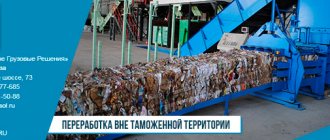HomeCustoms procedures Free warehouse - customs procedure
A free warehouse is both a customs procedure and a place where goods released under this customs procedure are stored. Goods are declared and released by customs without paying customs duties (duties, taxes, fees). The term “customs regime free customs warehouse” is sometimes used. In this case, non-tariff regulation measures are not applied. The territory of a free warehouse, as an infrastructure facility, does not differ from the territory of a temporary storage warehouse (TSW) or the territory of a customs warehouse (CU). This is also a fenced space with storage facilities (or without them), guarded and having a customs control zone (CZC). The presence of a ZC means that the facility is controlled by government agencies and customs officers are on duty.
The customs procedure code for free warehouse is EK77 or IM77, which is indicated when filling out column 1 of the customs declaration by a legal entity or individual entrepreneur.
Column 1 consists of three cells and is filled out as follows:
|
More details about filling
The difference between a free warehouse and a customs warehouse lies in the nature of the warehousing services provided. Temporary storage warehouses, as well as TS, provide participants in foreign economic activity with their warehousing services (services for sticking, labeling, completing (disassembling)) on a commercial basis. The only difference is that the duration of stay of goods on a temporary storage warehouse is 2 months, on a vehicle – up to 3 years. A free warehouse, as a rule, provides its services on a non-commercial basis, since the owners of free warehouses are large industrial enterprises that organize such warehouse complexes to solve their business problems.
There are currently no free warehouses in our country, but they are available in other EAEU member countries. According to the latest data published on the EEC website, in 2017 there were 972 temporary storage warehouses, 295 vehicles, and 65 free warehouses on the territory of the Union. Of the available warehouses, the vast majority (61 warehouses) belong to Kazakh enterprises and only 4 to Kyrgyzstan. In 2021, there were 53 free warehouses in Kazakhstan, and 50 a year earlier.
An example of a free warehouse. Since 2005, the joint Russian-Kazakh enterprise Kamaz-Engineering JSC began its activities in the Kazakh city of Kokshetau, which received the right to assemble well-known brand trucks from Russian spare parts and components in the territory of the Republic of Kazakhstan. Spare parts come to Kazakhstan directly from Naberezhnye Chelny. In the area of the city of Kokshetau, the company opened a free warehouse and received a certificate of inclusion in the register of owners of free warehouses. From here, the spare parts go directly to the conveyor line. Initially, dump trucks and shift buses were assembled here. Today, the range of cars produced is much wider - mass production of fuel tankers, tankers, flatbed trucks, semi-trailers, truck tractors, cement trucks, cranes, and special vehicles has been established. Finished trucks are certified, have the status of goods of the Union, they are covered by a full factory warranty, and they can be exported to other countries outside the EAEU.
Contents of the customs procedure free warehouse
The customs procedure for a free warehouse is limited geographically, since it is valid only within the boundaries of the warehouse. This procedure does not include goods prohibited for import (export) into the customs territory of the EAEU (goods from the sanctions list, hazardous waste, weapons, endangered species of flora and fauna), excisable goods (cars, alcoholic beverages, cigarettes). When declaring goods, customs duties, taxes and other customs payments are not paid.
Important! Only a legal entity or individual entrepreneur can place their cargo under the customs procedure of a customs warehouse.
The validity period of this procedure, that is, the duration of the customs regime for a free warehouse, is not regulated by law.
Declaration is carried out by the owner of the cargo or his customs representative - a customs broker.
The owner of a free warehouse must be included in the official register. Inclusion conditions:
- Status of a legal entity registered in any country of the EAEU;
- Have fenced storage areas at your disposal;
- To locate a warehouse complex on the territory of the Russian Federation, its future owner needs to deposit 10,000,000 rubles into the account of the Russian Treasury. (guarantee that the owner of the CC will fulfill his obligations to customs).
Conditions for including a person in the register of vehicle owners
The owner of a vehicle can be a legal entity that is not a state-owned enterprise, a state unitary enterprise, an enterprise specified in Part 1 of Article 274 of the Law, as well as a person associated with these enterprises.
The conditions for inclusion in the register of vehicle owners are:
- Ownership, economic management, operational management or lease (sublease) of structures, premises (parts of premises) and (or) open areas intended for use as a customs warehouse and meeting the requirements established by Article 367 of the Law. If structures, premises (parts of premises) and (or) open areas are leased (subleased) on the day of filing an application for inclusion in the register of vehicle owners, then the lease (sublease) agreement in relation to such structures, premises (parts of premises) and (or ) open areas must be concluded for a period of at least 1 year.
- For legal entities applying for inclusion in the register of vehicle owners as owners of an open type vehicle, it is mandatory to have an insurance contract for the risk of civil liability of the owner of a customs warehouse, which may occur as a result of causing damage to the goods of other persons in storage, or violation of other terms of storage agreements with by other persons.
The amount of the insured amount is determined based on:
- 3,500 rubles for each full and partial square meter of usable area, if an open area is used as a customs warehouse, or
- 1000 rubles for each full and incomplete cubic meter of useful volume, if the premises are used as a customs warehouse. The minimum amount of insurance cannot be less than 2,000,000 rubles.
- Absence on the day of application to the customs authority of unpaid customs duties, special, anti-dumping or countervailing duties, penalties, interest.
- Providing security for the payment of customs duties in the amount of at least 2,500,000 rubles, and for open-type vehicles an additional 300 rubles for each full and incomplete cubic meter of useful volume of the premises, if the premises are used as a customs warehouse, and 1,000 rubles for each full and incomplete square meter meter of usable area.
- The owner of the customs warehouse has no unfulfilled obligation to pay an administrative fine imposed on the owner of the vehicle on the basis of a resolution that has entered into legal force in a case of an administrative offense, liability for which is provided for in Articles 16.5, 16.13, 16.14, 16.15, parts 2 and 3 of Article 16.19, parts 2 and 3 Article 16.23 of the Code of the Russian Federation on Administrative Offenses, except for cases where the deadline for execution of the decision to impose an administrative fine has expired.
It is important to note that bringing the owner of a customs warehouse to administrative liability for an administrative offense provided for in Part 2 of Article 16.23 of the Code of Administrative Offenses of the Russian Federation or Part 1 of Article 16.9 of the Code of Administrative Offenses of the Russian Federation, during the period when the person is considered subject to administrative punishment, is grounds for exclusion from the Register of Vehicle Owners .
Also, the basis for removing a person from the vehicle register is bringing him to administrative responsibility for administrative offenses provided for in Art. 16.5, 16.13, 16.14, 16.15, part 2 and part 3 of Art. 16.19, part 3 art. 16.23 of the Code of Administrative Offenses of the Russian Federation, during the period when a person is considered subject to administrative punishment in cases of administrative offenses provided for in these articles, provided that the amount of administrative fines imposed under these articles in the aggregate amounted to 250,000 rubles or more.
The period during which a person is considered subject to administrative punishment under the above articles is 1 year from the date of entry into force of the relevant resolution (decision) to bring the person to administrative responsibility.
Terms and cost of registration under the free warehouse procedure
The processing time for a free warehouse procedure is 1 day!
At the same time, the price or cost of customs clearance services for goods under the customs procedure of a free warehouse in our company is the minimum in the market and depends on the place of customs clearance and the tasks set by the participant in foreign trade activities, on average it can be:
- Legal entity or individual entrepreneur - 5,000-15,000 rubles.
Found it cheaper? - Let us know!
We will make you a better offer!
general information
The provisions on keeping records of materials in the warehouses of enterprises are prescribed in the order of the Ministry of Finance of Russia dated January 28, 2001 No. 119n. The organization can also approve private norms, but they should not contradict the law.
Management must assign certain officials the responsibility for receiving and accounting for materiel in each warehouse. This can be done by a warehouse manager or a storekeeper. They will also be responsible for ensuring the correctness of receipt, issue or accounting of inventory items. They will also need to correctly register vacation or acceptance of goods or other valuables, and maintain all the necessary documentation.
For your information! The company must enter into full financial liability agreements with these employees.
In the regulations on warehouse accounting, you can specify the procedure for transferring information and papers from the warehouse to the company’s accountants and prescribe the interaction of these departments (features of document flow). This document should also contain information about the structure of the warehouse, inventory rules, and features of inventory accounting.
Picking and shipment
31. Never release cargo without accompanying documents. The ECAM warehouse management system allows you to generate waybills, invoices, TORG-12 and many other documents.
32. Develop picking routes, set deadlines for preparing accompanying documents.
33. Set the time for receiving applications from clients: for example, applications submitted after 16:00 are processed the next day, applications submitted before 12:00 are processed on the same day after 15:00, etc. Appoint an official who will be authorized to make decisions on changes to the picking time regulations.
34. Determine priority items for shipment. This:
- orders that will be delivered to the client earlier;
- orders for the last unloading point of the carrier vehicle.
35. It is reasonable to use a combination of two configuration methods:
- individual, when the required amount of goods for one order is withdrawn from departments;
- complex, when a product that is present in several orders is withdrawn.
Designate an employee who will decide on the picking method.
36. Place the assembled goods in a container, place it on a separate pallet, and wrap it with film. Label with the customer's name and delivery address.
37. Create a “Picking Log”, where each employee responsible for order picking will sign.
38. Inspect the vehicle for suitability for the load being transported. Do not ship to inappropriate vehicles.
39. Do not exceed the permitted carrying capacity of the vehicle or axle load.
40. Avoid bulk loading or placing heavy goods on top of light ones. If the product is damaged during shipment, replace it immediately - a return from the client is inevitable, but will cost more. Upon completion of loading, we seal the vehicle in accordance with the established regulations.
Cost reduction, optimal budgeting
71. Manage the cost of operations, which is calculated as the dependence of processing costs on cargo turnover over a period of time. Cost data will allow you to see ways to optimize technological processes.
72. Make the cost indicator the main motivation of management personnel: the lower it is, the more bonuses.
73. If possible, determine the cost of each operation - this will help to identify and eliminate unnecessary ones that are not profitable.
74. To reduce costs, implement IT technologies and lean principles.
75. Reduce the number of manual operations involved in moving loads to the minimum possible. Labor productivity will increase - costs will decrease.
76. Increase the level of staff training. Create a flexible motivation system.
77. Approve standards for consumables. Review them periodically.
78. Make a budget in advance - this will allow you to spend money efficiently.
79. Give the manager some financial independence: let him decide on the priority of payments.
80. Remember! The warehouse doesn't spend money, it earns it! There are many ways:
Warehouse equipment
61. Loading and unloading equipment is very expensive. It is better to calculate the required quantity using the well-known Gadzhinsky method. It is important to correctly calculate the stock indicator: when a certain number of carts during unloading can be supplemented with idle ones from a neighboring department.
62. Each piece of equipment must be assigned to a specific person - individual responsibility increases its service life many times over.
63. The technical department should have everything necessary for maintenance: brushes, rags, a vacuum cleaner, buckets. Lubrication and maintenance materials should also be available and located in the technical department.
64. Please note that employees working with complex equipment are required to undergo training. To conduct training, you must enter into a contract with the training organization.
65. Has the warranty period expired? Carry out an inspection on the basis of which you can decide on the advisability of further use, sale, or purchase of new equipment.
66. Try to purchase from one manufacturer. Spare parts from decommissioned equipment are suitable for repair.
67. The entry of equipment into a carriage or vehicle body is justified. Use overpasses and control bridges for this.
68. When choosing a manufacturer, consider:
- cost, payment terms;
- lifetime;
- reviews from other buyers;
- specifications;
- How is service organized?
69. On a level floor, use wheels with a polyurethane coating. For uneven earthen floors or asphalt surfaces, use rubber wheels or nylon rollers.
70. Buy 80% hydraulic trolleys with two rollers - to work along the entire length of the pallet. 20% of trolleys with one roller are enough for working with a pallet from the side.









